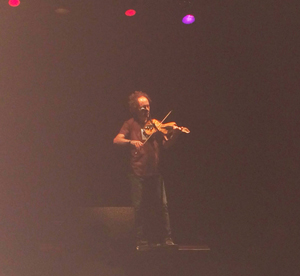By Daniel Hautzinger

When a musician sets off on a path away from established musical conventions, he takes a great risk. Possible fans may avoid the trailblazer because of difficulty in labeling him, and innovation is often unsuccessful or distasteful to most people. Classical music listeners might shun Silverman because they assume electric means raucous, while rock aficionados might assume Silverman’s Juilliard training and work with classical composers means long pieces that they don’t like.
Yet Silverman is a talented player, with attributes and music that could appeal to fans across the spectrum, as he demonstrated on July 21 at the Beachland Ballroom in Collinwood.
Silverman’s current violin looks like a mini electric guitar, and can sound like one too. In fact, one of the easiest comparisons with Silverman is to an eighties guitar hero like Joe Satriani or Steve Vai, though Silverman doesn’t shred as often. Not that he couldn’t; his technique is good enough to release flurries of notes, as he demonstrated at the Beachland in improvisations around a Bach piece and “Mojo Perpetuo” from his second electric violin concerto, Axis and Orbits.
Like Satriani, Silverman is obsessed with effects. He seems so excited that he can change the sound of his instrument that he never allows the pure tone of a violin to emerge unaltered. Distortion, wah-wah, and echo effects were effective in selections like Kenji Bunch’s concerto for Silverman, Embrace, or Jimi Hendrix’s 1983, where looped riffs were layered to create an intricate soundscape, but by the end of the night the constant reverb had become an intrusive distraction.
The electric violin opens up other possibilities as well: the two extra strings expand the instrument’s range to include thick bass notes. In Silverman’s own Matisse: La Danse, the extra notes allowed him to take on the role of bassist and guitar soloist, providing his own harmonic underpinning.
Loop pedals are also an essential tool for Silverman. They let him create solo performances of concertos composed for him like his own, Bunch’s or John Adams’s The Dharma at Big Sur. In excerpts from Dharma, he slowly built up the wide, peaceful chords of the original orchestration before launching into the mesmerizing, rhapsodic solo part.
Despite the versatility and potential of the electric violin, it seems like Silverman is still groping for a musical style to fully exploit the many possibilities of his instrument. While his music is already enjoyable, I can’t help but feel that there is an undiscovered genre or use for the electric violin that would lead to widespread adoption by other musicians. Hopefully Silverman’s search will find it.
Published on ClevelandClassical.com July 25, 2014.
Click here for a printable copy of this article.



